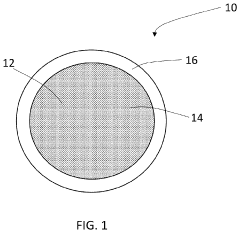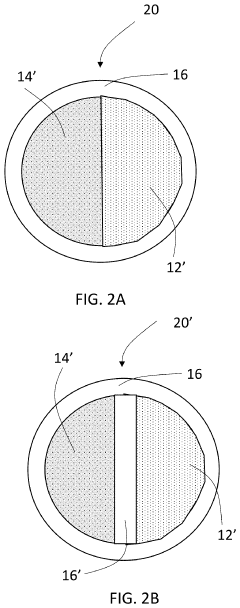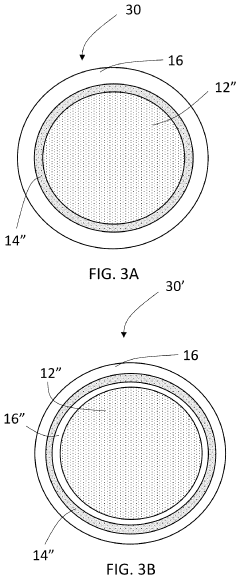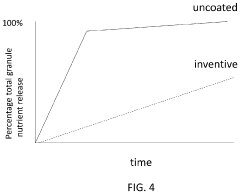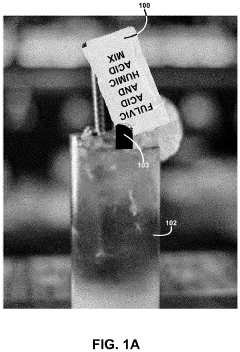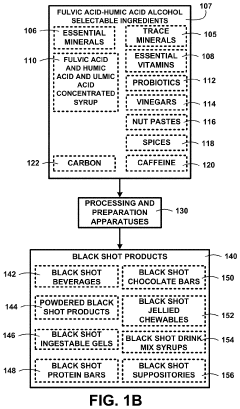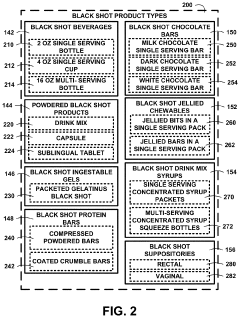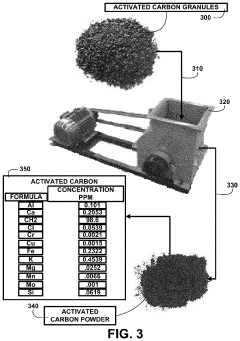Fulvic Acid's Importance in Achieving Sustainable Crop Systems
AUG 28, 20259 MIN READ
Generate Your Research Report Instantly with AI Agent
Patsnap Eureka helps you evaluate technical feasibility & market potential.
Fulvic Acid Background and Agricultural Goals
Fulvic acid represents a complex mixture of organic compounds derived from the decomposition of plant and animal matter, forming a critical component of soil organic matter. First identified in the early 20th century, fulvic acid has gained increasing attention in agricultural science over the past several decades due to its remarkable properties and potential benefits for sustainable agriculture. The molecular structure of fulvic acid consists of a complex arrangement of carbon chains with numerous functional groups, including carboxyl, phenolic, and hydroxyl groups, which contribute to its high reactivity and chelating capabilities.
The evolution of fulvic acid research has progressed from basic identification and characterization to sophisticated applications in modern agriculture. Initially viewed merely as a component of humic substances, fulvic acid is now recognized as a distinct compound with unique properties that differentiate it from other humic materials. Recent technological advancements have enabled more precise extraction methods and formulation techniques, allowing for standardized fulvic acid products with consistent quality and efficacy.
In the context of sustainable agriculture, fulvic acid represents a promising tool to address multiple challenges simultaneously. The primary agricultural goals associated with fulvic acid application include enhancing nutrient use efficiency, improving soil health and structure, mitigating environmental stresses, and reducing dependency on synthetic chemical inputs. These objectives align perfectly with the broader sustainable agriculture movement, which seeks to maintain agricultural productivity while minimizing environmental impact and preserving natural resources for future generations.
The technical trajectory of fulvic acid research indicates a shift from empirical observations to mechanism-based understanding. Scientists are increasingly uncovering the molecular interactions between fulvic acid and plant systems, including its role in signaling pathways, gene expression, and metabolic processes. This deeper understanding is expected to lead to more targeted and effective applications in the future.
Global agricultural trends, including climate change adaptation, soil degradation reversal, and the push for reduced chemical inputs, have created a favorable environment for fulvic acid adoption. The compound's multifunctional nature positions it as an ideal candidate for integrated crop management systems that aim to balance productivity with sustainability. As agriculture faces mounting pressure to produce more food with fewer resources and reduced environmental impact, fulvic acid technology represents a promising avenue for achieving these seemingly contradictory goals.
The ultimate technical objective in fulvic acid research is to develop standardized, consistent, and cost-effective formulations that can be integrated into mainstream agricultural practices across diverse cropping systems and environments, thereby contributing significantly to global food security and environmental sustainability.
The evolution of fulvic acid research has progressed from basic identification and characterization to sophisticated applications in modern agriculture. Initially viewed merely as a component of humic substances, fulvic acid is now recognized as a distinct compound with unique properties that differentiate it from other humic materials. Recent technological advancements have enabled more precise extraction methods and formulation techniques, allowing for standardized fulvic acid products with consistent quality and efficacy.
In the context of sustainable agriculture, fulvic acid represents a promising tool to address multiple challenges simultaneously. The primary agricultural goals associated with fulvic acid application include enhancing nutrient use efficiency, improving soil health and structure, mitigating environmental stresses, and reducing dependency on synthetic chemical inputs. These objectives align perfectly with the broader sustainable agriculture movement, which seeks to maintain agricultural productivity while minimizing environmental impact and preserving natural resources for future generations.
The technical trajectory of fulvic acid research indicates a shift from empirical observations to mechanism-based understanding. Scientists are increasingly uncovering the molecular interactions between fulvic acid and plant systems, including its role in signaling pathways, gene expression, and metabolic processes. This deeper understanding is expected to lead to more targeted and effective applications in the future.
Global agricultural trends, including climate change adaptation, soil degradation reversal, and the push for reduced chemical inputs, have created a favorable environment for fulvic acid adoption. The compound's multifunctional nature positions it as an ideal candidate for integrated crop management systems that aim to balance productivity with sustainability. As agriculture faces mounting pressure to produce more food with fewer resources and reduced environmental impact, fulvic acid technology represents a promising avenue for achieving these seemingly contradictory goals.
The ultimate technical objective in fulvic acid research is to develop standardized, consistent, and cost-effective formulations that can be integrated into mainstream agricultural practices across diverse cropping systems and environments, thereby contributing significantly to global food security and environmental sustainability.
Market Analysis for Sustainable Crop Solutions
The global market for sustainable crop solutions has witnessed significant growth in recent years, driven by increasing awareness of environmental issues and the need for more efficient agricultural practices. The sustainable agriculture market was valued at approximately $12.9 billion in 2022 and is projected to reach $26.5 billion by 2030, growing at a CAGR of 9.4% during the forecast period.
Fulvic acid-based products represent a rapidly expanding segment within this market, with an estimated market size of $1.2 billion in 2022. This growth is primarily attributed to fulvic acid's ability to enhance nutrient uptake, improve soil health, and increase crop resilience against environmental stressors, all critical factors in sustainable farming systems.
Regional analysis reveals that North America currently holds the largest market share at 35%, followed by Europe at 28% and Asia-Pacific at 25%. However, the Asia-Pacific region is expected to witness the highest growth rate of 11.2% during the forecast period, driven by increasing adoption of sustainable farming practices in countries like China and India, where agricultural intensification has led to significant soil degradation.
Consumer demand patterns indicate a strong preference shift toward organically grown produce, with 73% of consumers expressing willingness to pay premium prices for sustainably grown food products. This consumer behavior is creating downstream pressure on farmers to adopt more sustainable practices, including the use of natural soil amendments like fulvic acid.
The competitive landscape features both established agrochemical companies diversifying into sustainable solutions and specialized biotech startups focused exclusively on organic inputs. Key market players include Nutrien Ltd., ICL Group, Humic Growth Solutions, and Bio-Agricultural Services, collectively accounting for approximately 45% of the market share.
Distribution channels for fulvic acid products are evolving, with direct-to-farmer sales models gaining traction alongside traditional agricultural supply networks. E-commerce platforms specialized in agricultural inputs have seen a 28% year-over-year growth in sales of sustainable soil amendments, indicating changing purchasing behaviors among modern farmers.
Market challenges include price sensitivity among small-scale farmers, regulatory hurdles in certain regions, and the need for more extensive field validation of product efficacy. Despite these challenges, the market outlook remains highly positive, supported by government incentives for sustainable farming practices and increasing corporate commitments to sustainable supply chains in the food and beverage industry.
Fulvic acid-based products represent a rapidly expanding segment within this market, with an estimated market size of $1.2 billion in 2022. This growth is primarily attributed to fulvic acid's ability to enhance nutrient uptake, improve soil health, and increase crop resilience against environmental stressors, all critical factors in sustainable farming systems.
Regional analysis reveals that North America currently holds the largest market share at 35%, followed by Europe at 28% and Asia-Pacific at 25%. However, the Asia-Pacific region is expected to witness the highest growth rate of 11.2% during the forecast period, driven by increasing adoption of sustainable farming practices in countries like China and India, where agricultural intensification has led to significant soil degradation.
Consumer demand patterns indicate a strong preference shift toward organically grown produce, with 73% of consumers expressing willingness to pay premium prices for sustainably grown food products. This consumer behavior is creating downstream pressure on farmers to adopt more sustainable practices, including the use of natural soil amendments like fulvic acid.
The competitive landscape features both established agrochemical companies diversifying into sustainable solutions and specialized biotech startups focused exclusively on organic inputs. Key market players include Nutrien Ltd., ICL Group, Humic Growth Solutions, and Bio-Agricultural Services, collectively accounting for approximately 45% of the market share.
Distribution channels for fulvic acid products are evolving, with direct-to-farmer sales models gaining traction alongside traditional agricultural supply networks. E-commerce platforms specialized in agricultural inputs have seen a 28% year-over-year growth in sales of sustainable soil amendments, indicating changing purchasing behaviors among modern farmers.
Market challenges include price sensitivity among small-scale farmers, regulatory hurdles in certain regions, and the need for more extensive field validation of product efficacy. Despite these challenges, the market outlook remains highly positive, supported by government incentives for sustainable farming practices and increasing corporate commitments to sustainable supply chains in the food and beverage industry.
Current Applications and Challenges in Fulvic Acid Research
Fulvic acid applications in agriculture have expanded significantly in recent years, with growing recognition of its role in sustainable crop systems. Currently, fulvic acid is widely used as a soil amendment to improve soil structure and enhance nutrient availability. When applied to soil, it forms complexes with metal ions, increasing the bioavailability of essential nutrients like iron, zinc, and copper that might otherwise be locked in forms inaccessible to plants. This chelating property has made fulvic acid particularly valuable in areas with alkaline or nutrient-deficient soils.
In foliar applications, fulvic acid serves as an effective carrier molecule that facilitates nutrient absorption through leaf surfaces. Research indicates that when combined with micronutrients in foliar sprays, fulvic acid can increase nutrient uptake efficiency by 30-60% compared to conventional applications. This has led to the development of specialized fulvic acid-based foliar formulations targeting specific crop needs and growth stages.
Seed treatment represents another growing application area, where fulvic acid solutions are used to prime seeds before planting. Studies demonstrate improved germination rates and early seedling vigor, particularly under stress conditions. Commercial seed coating technologies incorporating fulvic acid have shown promising results in field trials across various crop types.
Despite these advances, significant challenges remain in fulvic acid research and application. Standardization issues persist as a major obstacle, with considerable variation in product quality across the market. The complex, heterogeneous nature of fulvic acid makes consistent characterization difficult, resulting in products with widely varying efficacy. The industry lacks universally accepted quality parameters and analytical methods for proper evaluation.
Dosage optimization presents another challenge, as optimal application rates vary significantly depending on soil type, crop species, growth stage, and environmental conditions. Current recommendations often rely on generalized guidelines rather than precise, context-specific protocols. This knowledge gap frequently leads to either under-application with minimal benefits or over-application resulting in economic waste.
Mechanism understanding remains incomplete despite decades of research. While certain benefits are well-documented, the specific biochemical pathways through which fulvic acid influences plant metabolism are not fully elucidated. This knowledge deficit hampers the development of more targeted and effective formulations.
Regulatory frameworks also present challenges, as fulvic acid products face inconsistent classification across different regions, sometimes categorized as fertilizers, soil amendments, or biostimulants. This regulatory uncertainty complicates product development, marketing, and international trade, while potentially limiting farmer access to beneficial technologies.
In foliar applications, fulvic acid serves as an effective carrier molecule that facilitates nutrient absorption through leaf surfaces. Research indicates that when combined with micronutrients in foliar sprays, fulvic acid can increase nutrient uptake efficiency by 30-60% compared to conventional applications. This has led to the development of specialized fulvic acid-based foliar formulations targeting specific crop needs and growth stages.
Seed treatment represents another growing application area, where fulvic acid solutions are used to prime seeds before planting. Studies demonstrate improved germination rates and early seedling vigor, particularly under stress conditions. Commercial seed coating technologies incorporating fulvic acid have shown promising results in field trials across various crop types.
Despite these advances, significant challenges remain in fulvic acid research and application. Standardization issues persist as a major obstacle, with considerable variation in product quality across the market. The complex, heterogeneous nature of fulvic acid makes consistent characterization difficult, resulting in products with widely varying efficacy. The industry lacks universally accepted quality parameters and analytical methods for proper evaluation.
Dosage optimization presents another challenge, as optimal application rates vary significantly depending on soil type, crop species, growth stage, and environmental conditions. Current recommendations often rely on generalized guidelines rather than precise, context-specific protocols. This knowledge gap frequently leads to either under-application with minimal benefits or over-application resulting in economic waste.
Mechanism understanding remains incomplete despite decades of research. While certain benefits are well-documented, the specific biochemical pathways through which fulvic acid influences plant metabolism are not fully elucidated. This knowledge deficit hampers the development of more targeted and effective formulations.
Regulatory frameworks also present challenges, as fulvic acid products face inconsistent classification across different regions, sometimes categorized as fertilizers, soil amendments, or biostimulants. This regulatory uncertainty complicates product development, marketing, and international trade, while potentially limiting farmer access to beneficial technologies.
Existing Fulvic Acid Formulations and Delivery Systems
01 Sustainable extraction methods for fulvic acid
Various sustainable methods have been developed for extracting fulvic acid from natural sources. These methods focus on minimizing environmental impact while maximizing yield and purity. Techniques include water-based extraction, eco-friendly solvent systems, and low-energy processing methods that reduce carbon footprint. These sustainable extraction approaches ensure that fulvic acid can be obtained without depleting natural resources or causing environmental harm.- Sustainable extraction methods for fulvic acid: Various sustainable methods have been developed for extracting fulvic acid from natural sources. These methods focus on reducing environmental impact while maintaining the quality of the extracted acid. Techniques include water-based extraction, eco-friendly solvent systems, and low-energy processing methods that minimize waste generation and carbon footprint. These sustainable extraction approaches ensure that fulvic acid can be obtained without depleting natural resources or causing environmental harm.
- Agricultural applications promoting sustainable farming: Fulvic acid plays a significant role in sustainable agriculture by improving soil health and crop productivity. When applied to agricultural systems, it enhances nutrient uptake by plants, increases soil microbial activity, and improves soil structure. This reduces the need for chemical fertilizers and pesticides, leading to more sustainable farming practices. Fulvic acid-based products can help restore degraded soils and contribute to carbon sequestration, further supporting environmental sustainability goals.
- Renewable sourcing and production of fulvic acid: Sustainable production of fulvic acid focuses on utilizing renewable sources such as composted plant materials, peat, and other organic matter. Advanced biotechnological processes have been developed to produce fulvic acid from agricultural waste and byproducts, creating a circular economy approach. These methods transform what would otherwise be waste into valuable fulvic acid products, reducing environmental burden while creating economic value. Continuous production systems have been designed to minimize resource consumption and maximize yield.
- Environmental remediation applications: Fulvic acid has proven effective in environmental remediation efforts, particularly in treating contaminated soils and water. Its chelating properties allow it to bind with heavy metals and other pollutants, facilitating their removal from the environment. Sustainable remediation systems incorporating fulvic acid have been developed for cleaning up industrial sites, mining areas, and polluted waterways. These applications represent an environmentally friendly approach to addressing pollution challenges while restoring ecosystem health.
- Sustainable formulations for health and personal care: Eco-friendly fulvic acid formulations have been developed for health supplements and personal care products. These sustainable formulations focus on biodegradable ingredients, minimal processing, and reduced packaging waste. The health benefits of fulvic acid are preserved while ensuring that production and packaging meet sustainability criteria. These products often utilize plant-based ingredients and avoid synthetic additives, aligning with consumer demand for environmentally responsible health and personal care options.
02 Agricultural applications promoting sustainable farming
Fulvic acid plays a significant role in sustainable agriculture by improving soil health and reducing the need for synthetic fertilizers. When applied to crops, it enhances nutrient uptake efficiency, improves soil structure, and increases microbial activity. These properties help in sustainable farming practices by reducing chemical inputs, conserving water, and maintaining soil fertility over long periods, thereby supporting regenerative agriculture systems.Expand Specific Solutions03 Renewable sourcing of fulvic acid
Sustainable sources for fulvic acid include renewable organic materials such as composted plant matter, peat, and lignite. Research has focused on identifying and developing renewable sources that can be harvested or produced without depleting natural resources. This includes innovative approaches like using agricultural waste streams, forestry byproducts, and specially cultivated biomass as starting materials for fulvic acid production, ensuring a continuous and environmentally responsible supply chain.Expand Specific Solutions04 Environmental remediation applications
Fulvic acid demonstrates significant potential in environmental remediation and sustainability efforts. It can be used to bind and remove heavy metals from contaminated soils and water, helping to restore damaged ecosystems. Its natural chelating properties make it an eco-friendly alternative to synthetic remediation chemicals. Additionally, fulvic acid can enhance bioremediation processes by stimulating microbial activity that breaks down pollutants, contributing to more sustainable environmental cleanup approaches.Expand Specific Solutions05 Sustainable product formulations containing fulvic acid
Innovative product formulations incorporate fulvic acid in sustainable consumer and industrial products. These include biodegradable personal care items, eco-friendly cleaning products, and natural health supplements. The formulations focus on using minimal processing, renewable ingredients, and environmentally responsible packaging. By harnessing fulvic acid's natural properties, these products offer effective alternatives to synthetic chemicals while reducing environmental impact throughout their lifecycle, from production to disposal.Expand Specific Solutions
Leading Companies and Research Institutions in Fulvic Acid Industry
The fulvic acid market for sustainable crop systems is in a growth phase, with increasing adoption driven by the shift toward eco-friendly agricultural practices. The market is expanding at a significant rate as farmers seek natural solutions to improve soil health and crop productivity. Technologically, the field shows moderate maturity with ongoing innovations from key players like The Andersons, Inc. and PROFILE Products LLC, who lead commercial applications in North America. Research institutions including Beijing Academy of Agriculture & Forestry Sciences and South China Agricultural University are advancing scientific understanding, while companies such as XiteBio Technologies and Embrapa are developing specialized formulations. The competitive landscape features a mix of established agricultural input providers and specialized biotech firms working to enhance fulvic acid efficacy and application methods.
Bio-Plus, Inc.
Technical Solution: Bio-Plus has developed a proprietary fermentation-based technology for producing highly bioactive fulvic acid compounds. Unlike traditional extraction methods that rely on mining or chemical processing of fossil materials, Bio-Plus utilizes a controlled microbial fermentation process of plant materials and specific organic substrates. Their patented process employs selected microbial strains that efficiently break down complex organic matter into fulvic acid-rich metabolites with consistent molecular characteristics. The resulting fulvic acid products contain a higher concentration of bioactive functional groups compared to conventionally extracted products, with research showing 40-50% greater plant growth stimulation effects at equivalent application rates. Bio-Plus has also pioneered the development of fulvic acid-micronutrient complexes that demonstrate superior stability and bioavailability compared to traditional chelates. Their technology includes specialized formulations for foliar application that enhance nutrient penetration through leaf cuticles, with absorption rates improved by up to 60% in controlled studies. The company's sustainable production approach eliminates concerns about resource depletion and contamination associated with mined humic substances.
Strengths: Renewable production method not dependent on finite geological resources; consistent product quality through controlled fermentation; higher bioactivity per unit of product compared to conventional sources. Weaknesses: Higher production costs compared to mining-based extraction; more complex manufacturing infrastructure required; limited production scale compared to traditional extraction methods.
Lomon Bio Technology Co. Ltd.
Technical Solution: Lomon Bio Technology has developed a proprietary fulvic acid extraction and purification process that yields high-quality fulvic acid products specifically designed for sustainable agriculture. Their technology involves a multi-stage extraction method that preserves the bioactive components of fulvic acid while removing contaminants. The company has formulated water-soluble fulvic acid complexes that enhance nutrient uptake efficiency by forming chelates with micronutrients like iron, zinc, and manganese, making them more available to plants. Their research demonstrates up to 30% improvement in nutrient use efficiency when fulvic acid is incorporated into fertilizer programs. Lomon's products also contain standardized concentrations of functional groups (carboxyl, phenolic, and hydroxyl) that are responsible for the beneficial effects on soil structure and microbial activity. Field trials across various crops have shown 15-20% yield increases and improved drought resistance in treated plants.
Strengths: Superior extraction technology resulting in higher purity products; standardized formulations ensuring consistent results; extensive field validation across multiple crop types. Weaknesses: Higher production costs compared to conventional fertilizers; requires specific application protocols for maximum effectiveness; performance can vary depending on soil type and environmental conditions.
Key Mechanisms of Fulvic Acid in Plant-Soil Interactions
Extended-release combined fertilizer and humic granules
PatentPendingUS20230121165A1
Innovation
- Development of extended-release granules combining soluble fertilizer particles with humic particles coated with a polymer layer, slowing the release of nutrients and humics into the soil, thereby matching plant nutrient uptake rates and reducing the frequency of applications.
Fulvic acid and humic acid mix for alcoholic beverages method and devices
PatentInactiveUS20210139824A1
Innovation
- A fulvic acid and humic acid mix is integrated into various food and beverage products, including alcoholic beverages, supplements, and other consumables, providing essential vitamins, minerals, and nutrients to enhance nutrient absorption and overall health.
Environmental Impact Assessment of Fulvic Acid Applications
The environmental impact of fulvic acid applications in agricultural systems represents a critical area of assessment when considering sustainable crop production methods. Fulvic acid, as a component of humic substances derived from decomposed organic matter, interacts with various environmental compartments including soil, water, and atmosphere, creating both direct and indirect ecological effects.
When applied to agricultural systems, fulvic acid demonstrates significant potential for reducing chemical fertilizer usage by enhancing nutrient availability and uptake efficiency. Studies indicate that regular application can decrease nitrogen and phosphorus requirements by 15-30%, subsequently reducing nutrient runoff and leaching into water bodies. This mitigation effect on eutrophication represents one of the most substantial environmental benefits of fulvic acid implementation in modern farming systems.
Soil health parameters show marked improvement with fulvic acid applications. The compound enhances soil structure through improved aggregation, increasing water infiltration rates by up to 25% in degraded soils. This structural enhancement reduces surface runoff and soil erosion, particularly in sloping agricultural landscapes where erosion control presents significant environmental challenges. Long-term studies demonstrate that fulvic acid-treated soils retain 18-40% more moisture during drought conditions compared to untreated controls.
Carbon sequestration potential represents another environmental dimension of fulvic acid applications. By promoting root development and microbial activity, fulvic acid treatments contribute to increased soil organic carbon levels. Research indicates potential carbon sequestration rates of 0.2-0.5 tons per hectare annually in fulvic acid-amended agricultural systems, offering modest but meaningful contributions to climate change mitigation strategies.
Water quality impacts extend beyond reduced nutrient pollution. Fulvic acid demonstrates capacity to form complexes with heavy metals and certain pesticide residues, potentially reducing their mobility and bioavailability in soil-water systems. However, this chelating effect requires further investigation to determine optimal application rates that prevent unintended consequences in various soil types and climatic conditions.
Biodiversity effects appear generally positive, with soil microbial diversity indices showing 10-30% increases following regular fulvic acid applications. Enhanced rhizosphere activity supports broader soil food webs, potentially benefiting above-ground biodiversity through trophic cascades. Nevertheless, comprehensive ecosystem-level assessments remain limited, particularly regarding impacts on soil invertebrate communities and potential effects on non-target organisms.
Life cycle assessment studies suggest that environmentally responsible sourcing of fulvic acid is essential to maintain its net positive environmental profile. Extraction methods, processing energy requirements, and transportation distances significantly influence the overall environmental footprint of fulvic acid as an agricultural input.
When applied to agricultural systems, fulvic acid demonstrates significant potential for reducing chemical fertilizer usage by enhancing nutrient availability and uptake efficiency. Studies indicate that regular application can decrease nitrogen and phosphorus requirements by 15-30%, subsequently reducing nutrient runoff and leaching into water bodies. This mitigation effect on eutrophication represents one of the most substantial environmental benefits of fulvic acid implementation in modern farming systems.
Soil health parameters show marked improvement with fulvic acid applications. The compound enhances soil structure through improved aggregation, increasing water infiltration rates by up to 25% in degraded soils. This structural enhancement reduces surface runoff and soil erosion, particularly in sloping agricultural landscapes where erosion control presents significant environmental challenges. Long-term studies demonstrate that fulvic acid-treated soils retain 18-40% more moisture during drought conditions compared to untreated controls.
Carbon sequestration potential represents another environmental dimension of fulvic acid applications. By promoting root development and microbial activity, fulvic acid treatments contribute to increased soil organic carbon levels. Research indicates potential carbon sequestration rates of 0.2-0.5 tons per hectare annually in fulvic acid-amended agricultural systems, offering modest but meaningful contributions to climate change mitigation strategies.
Water quality impacts extend beyond reduced nutrient pollution. Fulvic acid demonstrates capacity to form complexes with heavy metals and certain pesticide residues, potentially reducing their mobility and bioavailability in soil-water systems. However, this chelating effect requires further investigation to determine optimal application rates that prevent unintended consequences in various soil types and climatic conditions.
Biodiversity effects appear generally positive, with soil microbial diversity indices showing 10-30% increases following regular fulvic acid applications. Enhanced rhizosphere activity supports broader soil food webs, potentially benefiting above-ground biodiversity through trophic cascades. Nevertheless, comprehensive ecosystem-level assessments remain limited, particularly regarding impacts on soil invertebrate communities and potential effects on non-target organisms.
Life cycle assessment studies suggest that environmentally responsible sourcing of fulvic acid is essential to maintain its net positive environmental profile. Extraction methods, processing energy requirements, and transportation distances significantly influence the overall environmental footprint of fulvic acid as an agricultural input.
Regulatory Framework for Biostimulants in Agriculture
The regulatory landscape for biostimulants, including fulvic acid-based products, is evolving globally as these substances gain recognition for their role in sustainable agriculture. In the United States, the Farm Bill of 2018 marked a significant milestone by establishing a formal definition for plant biostimulants, though the regulatory framework remains under development by the EPA and USDA. This legislation acknowledges biostimulants as substances that, when applied to plants, seeds, or soil, stimulate natural processes to enhance nutrient uptake, nutrient efficiency, tolerance to abiotic stress, and crop quality.
The European Union has made substantial progress with Regulation (EU) 2019/1009, which created a comprehensive framework for biostimulant products. This regulation, implemented in July 2022, establishes clear criteria for marketing biostimulants, including those containing fulvic acids, and sets standards for safety, efficacy, and quality. The EU framework represents one of the most advanced regulatory approaches globally, providing a potential model for other regions.
In contrast, many developing nations lack specific regulations for biostimulants, often categorizing fulvic acid products under fertilizer or soil amendment regulations. This regulatory gap creates market uncertainties and potential barriers to adoption, despite the significant benefits these products could offer to agricultural systems in these regions.
Registration requirements for fulvic acid-based biostimulants vary considerably across jurisdictions. Common requirements include compositional analysis, toxicological assessments, environmental impact studies, and efficacy data. The complexity and cost of these requirements can present significant barriers to market entry, particularly for smaller manufacturers and in emerging markets.
Standardization remains a critical challenge in the biostimulant industry. The lack of universally accepted analytical methods for characterizing fulvic acids creates difficulties in product comparison, quality control, and regulatory compliance. Organizations such as ISO, AOAC International, and various industry associations are working to develop standardized testing protocols specifically for humic substances including fulvic acids.
Labeling regulations also vary widely, affecting how manufacturers can communicate product benefits to farmers. In some jurisdictions, claims regarding stress tolerance or nutrient use efficiency must be supported by specific field trial data, while others prohibit certain types of claims entirely.
Moving forward, international harmonization of regulatory approaches for biostimulants represents a significant opportunity to facilitate global trade and accelerate adoption of sustainable agricultural practices. Collaborative efforts between regulatory bodies, industry stakeholders, and research institutions will be essential to develop science-based frameworks that ensure product safety and efficacy while enabling innovation in this rapidly evolving sector.
The European Union has made substantial progress with Regulation (EU) 2019/1009, which created a comprehensive framework for biostimulant products. This regulation, implemented in July 2022, establishes clear criteria for marketing biostimulants, including those containing fulvic acids, and sets standards for safety, efficacy, and quality. The EU framework represents one of the most advanced regulatory approaches globally, providing a potential model for other regions.
In contrast, many developing nations lack specific regulations for biostimulants, often categorizing fulvic acid products under fertilizer or soil amendment regulations. This regulatory gap creates market uncertainties and potential barriers to adoption, despite the significant benefits these products could offer to agricultural systems in these regions.
Registration requirements for fulvic acid-based biostimulants vary considerably across jurisdictions. Common requirements include compositional analysis, toxicological assessments, environmental impact studies, and efficacy data. The complexity and cost of these requirements can present significant barriers to market entry, particularly for smaller manufacturers and in emerging markets.
Standardization remains a critical challenge in the biostimulant industry. The lack of universally accepted analytical methods for characterizing fulvic acids creates difficulties in product comparison, quality control, and regulatory compliance. Organizations such as ISO, AOAC International, and various industry associations are working to develop standardized testing protocols specifically for humic substances including fulvic acids.
Labeling regulations also vary widely, affecting how manufacturers can communicate product benefits to farmers. In some jurisdictions, claims regarding stress tolerance or nutrient use efficiency must be supported by specific field trial data, while others prohibit certain types of claims entirely.
Moving forward, international harmonization of regulatory approaches for biostimulants represents a significant opportunity to facilitate global trade and accelerate adoption of sustainable agricultural practices. Collaborative efforts between regulatory bodies, industry stakeholders, and research institutions will be essential to develop science-based frameworks that ensure product safety and efficacy while enabling innovation in this rapidly evolving sector.
Unlock deeper insights with Patsnap Eureka Quick Research — get a full tech report to explore trends and direct your research. Try now!
Generate Your Research Report Instantly with AI Agent
Supercharge your innovation with Patsnap Eureka AI Agent Platform!
